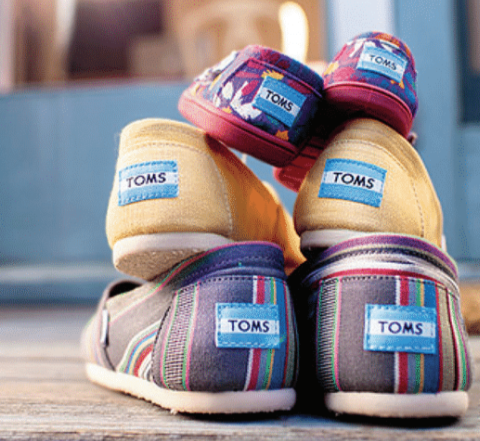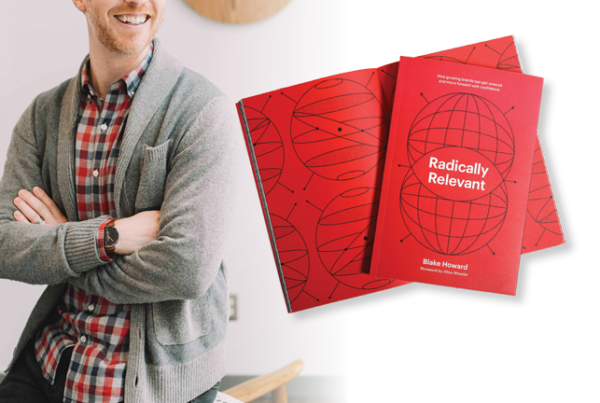TOMS CHARTS THE COURSE for a Comeback with Gen Z
and a New Cause-Related Marketing Strategy
It’s impossible to read a story about how to build your brand in 2022 without being told that you must have a purpose—some sort of higher calling that shows the contribution you make to the world at large. From Adweek to Entrepreneur to Forbes, everyone who is anyone has published articles explaining that it is not possible to win over today’s consumer without wearing your principles on your sleeve. At TOMS, making a social impact is old news. As Adweek says, the shoe brand “led the rise of the social impact space,” becoming the best-known company associated with purpose marketing.

T he Los Angeles-based company, which makes footwear and accessories (sunglasses, socks, apparel, beanies) for men, women, and children, got its start in 2006 and was resolute on giving back from the beginning. TOMS founder Blake Mycoskie pioneered what he called the One for One® model: the company gave away one pair of shoes to a child in need for every pair sold, a business approach that was ahead of its time. He came up with the idea on a trip to Argentina, where Mycoskie saw the impact that a single pair of shoes could have on the life of a child. In fact, the company name stems from the word tomorrow, which comes from the original concept of Shoes for Tomorrow. The proof is in the podiatry, so to speak. By 2018, TOMS had become a Certified B Corporation™, and by 2020 it had given away 100 million pairs of shoes.
To make this kind of charitable impact, TOMS had to sell a lot of shoes to a whole lot of happy customers with happy feet—and they did. Just seven years after its start, TOMS was making $250 million per year in sales. Millennials loved the idea of making a contribution with every pair of shoes they bought, and celebs such as Charlize Theron, Jessica Alba, Jennifer Garner, and even Snoop Dogg were wearing TOMS. Considering it’s difficult to find a pair of TOMS shoes that costs more than $150, that was an accomplishment. The company was valued at $625 million in 2014, but that’s when the tough times began. That year, Bain Capital bought a 50 percent ownership of TOMS, but then slow sales growth saw the brand struggle under its new owners. In 2019, TOMS was taken over by creditors.
Now, TOMS is charting a course for a comeback and targeting the next generation of young consumers: the twentysomethings of Generation Z. Part of the new brand strategy has been to evolve the One for One shoe-donation program into another charitable effort that resonates more with a younger target audience.
Today, TOMS gives away one-third of its profits for what it calls “grassroots goods, including cash grants and partnerships with community organizations, to drive sustainable change.” The company invests in three areas: boosting mental health, increasing access to opportunities, and ending gun violence. Those three main causes—in case you were unaware—are all near and dear to the hearts and minds of the Gen Z consumer. The company says that in 2021 it invested more than $2 million into 43 community-based organizations in 20 different communities. TOMS even gave $2 million to help COVID charities. When TOMS says on their website that they are “in business to improve lives,” they aren’t pulling your leg.
On the product side, TOMS has expanded its offerings to sneakers to align with current trends in footwear, and the price point remains approachable; none of the sneakers offered at TOMS.com cost more than $69. They have also evolved the slip-on Alpargata range that made the brand famous, offering models made from recycled cotton. Those shoes are part of the TOMS Earthwise collection, which features a variety of styles made with sustainable materials, including vegan shoes made with no animal by-products.
”As Adweek says, the shoe brand “led the rise of the
social impact space,” becoming the best- company associated with purpose marketing.
A “try fast, test fast” mentality means product developers can always experiment with new products and services. TOMS also places an emphasis on remaining connected with consumers. The company rewards customer service agents for taking time with customers on the phone and even using that time to explain what social cause their purchase will support.
Even in its marketing materials, TOMS wants to deliver value to potential customers, rather than just product or brand messaging. That doesn’t mean offering discounts or sales, but instead it means making consumers feel like they are playing a role in how the company does good in the world. For that reason, every piece of marketing content that TOMS creates must be relevant enough to create an instant connection as well as offer something of value.
The TOMS rewards program fits this authentic business model, offering members the chance to earn points when they buy the company’s gear and then exchange those points for more TOMS goods or use them to give back to one of the company’s grassroots partners. There are a number of ways to earn points beyond purchases, which also helps TOMS collect first-party data. These include celebrating your birthday with TOMS each year, updating your profile, or even connecting with TOMS on social media. Speaking of which, the company’s brand messaging is consistent on Instagram as well, where it has nearly one million followers. Of course, the TOMS Instagram page features a colorful palette of shoes, apparel, and sunglasses being worn in their element, from the backyard to city streets, but it also includes frequent posts on causes such as mental health and the environment.

A t the TOMS.com website, the company’s efforts to make a social impact are front and center—literally: an impact ad sits in the middle of the home page. Just below a product block is a link to learn how your purchase can help those with mental health issues find the help they need. When you click the link, TOMS takes you to a short video explaining just how that impact works, and they then encourage you to visit another web page with more details. The “Stories” section at the bottom of the page is full of articles about the causes TOMS is connected to. Even product pushes in this section explain how that item helps people in need.
TOMS has also used the limited-edition approach to drum up attention for its products, but always with a greater good in mind. In 2022, they partnered with fashion lifestyle brand Wildfang to create a limited-edition range designed to “make a bold statement and a real impact.” The collab supported organizations such as GirlForward, which is dedicated to creating and enhancing opportunities for girls who identify as refugees, immigrants, and asylum seekers.
If it all seems a bit too good to be true, rest assured that TOMS is authentic in its efforts. The company dedicates a robust section of its website to its impact report, which details where its donations go, the organizations they work with around the globe, how the company measures up against other Certified B Corporations, its efforts in diversity and inclusion, and sustainability commitments they have made for the future. Will it all resonate with Gen Z and send TOMS to lofty heights again? Time will tell, but one thing is for sure: TOMS will do plenty of good as it works to get there.
”Now, TOMS is charting a course for a comeback and targeting the next generation of young consumers: the twentysomethings of Generation Z.
- Leader in cause marketing and corporate social responsibility
- Reinventing itself with a new marketing strategy targeting Gen Z
- Certified B Corporation
Cause-related marketing (CRM) grew out of the 1990s marketing trend of relationship marketing. Cause-related marketing is the partnering of a for-profit business with a nonprofit organization for mutual benefit—to both increase profits and to better society in accordance with a brand’s corporate social responsibility.

Print that inspires
Request your free print inspiration kit and get highly personalized print samples right to your door.








